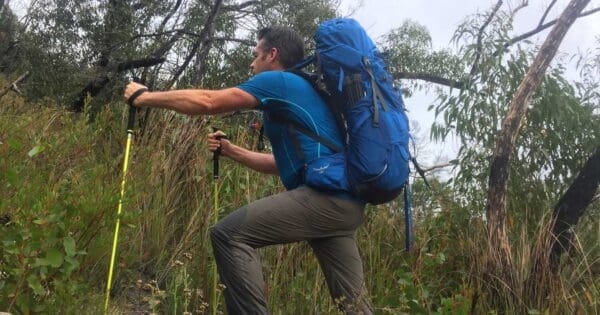For many hikers, the thrill of reaching a mountain summit or navigating a hidden waterfall takes center stage. But beneath the surface, hidden away from admiring glances, lies an unsung hero: the hiking boot sole. Whether you’re trekking in rugged boots, nimble trail runners, or hiking shoes, the sole plays a critical role in your journey. It’s the silent guardian of your safety, the key to your comfort, and the driving force behind your performance on the trail. By exploring the intricacies of sole design and understanding its key features, you can unlock the secrets of this crucial component and make informed choices for your specific needs. So, before you head out and hit the trail, take a moment to appreciate the sole – it might just be the most important step towards ensuring a safe, successful and enjoyable adventure.
The grip on traction
Imagine traversing a rain-slicked mountain path or scrambling across sun-baked scree with unwavering confidence. That’s the power of a well-designed sole. Its primary function is to provide traction, preventing slips and falls on various terrains. Different tread patterns offer distinct advantages:
- Deep, aggressive lugs: Think of them as claws digging into mud, snow, or loose rock. These provide exceptional grip on challenging surfaces but compromise flexibility on smoother paths.
- Shallower, smoother lugs: Picture navigating rocky ridges or well-maintained trails. These prioritise flexibility and comfort while maintaining good traction for moderate terrain.
- Self-cleaning wonders: Imagine mud magically disappearing! These cleverly designed soles shed debris, ensuring consistent grip in wet and muddy conditions.

Durability dilemma
A sole’s lifespan hinges on the rubber compound it’s crafted from. Softer compounds deliver superior initial grip but wear out faster, similar to tires designed for performance driving. Conversely, harder compounds prioritise durability like off-road tires, but their traction on specific surfaces might suffer.
The flexibility factor
A flexible sole mimics your natural foot movement, enhancing agility on technical terrain. Think of it as the difference between a ballet shoe and a hiking boot: flexibility allows for nimble maneuvering but can compromise stability on uneven surfaces. Finding the sweet spot between flexibility and support depends on your intended terrain and hiking style.
Weight considerations: A delicate balance
Imagine carrying extra baggage on your feet; that’s the trade-off with thicker, more aggressive soles. They offer superior grip and durability but come at the cost of added weight. Conversely, lighter soles prioritise agility and comfort, making them ideal for day hikes or less demanding terrain. Finding the right balance depends on your desired performance level and tolerance for additional weight.

Beyond Vibram: Exploring innovation
Vibram, a renowned brand, is synonymous with high-quality rubber compounds and diverse sole designs. However, the landscape extends beyond a single player. Brands like La Sportiva, Michelin, and Scarpa offer innovative solutions with unique features, like self-cleaning lugs or temperature-specific compounds. It’s crucial to explore these options to find the perfect match for your needs.
The perfect sole for your adventures
The ideal sole isn’t a one-size-fits-all solution. Consider the terrain you conquer, your comfort threshold, and the desired balance between durability and weight. Research, read expert reviews, and consult knowledgeable staff to find the perfect sole that empowers you to explore confidently and comfortably. Remember, a well-chosen sole is an investment in your safety and enjoyment on the trail.
By understanding the critical aspects of hiking boot soles, you can embark on your next adventure with confidence, knowing that your footwear is designed to support every step of your journey.






As someone who lost their tread at the top of a mountain in the Tararuas- yes, it does matter! 😂
Jacinta Helen oh that’s not a good time to loose it. What did you do to get back down?
I’ve been pretty happy with the tread on those boots in my pic. Five years old now and I hike with them regularly.
TBH I’m still a total fan of the US “Panama” tread pattern. Unfortunately, it’s out of fashion these days and harder to find on modern boots.
Here’s what a version of it looks like
Media: https://www.facebook.com/photo.php?fbid=10160115791948359&set=p.10160115791948359&type=3
Murky Murk looks like a retread off a car tyre. Robust.
Trail Hiking Australia Oh yeah. Sheds mud easily too.
Murky Murk I was just thinking that. Better than the all-terrains on my 4WD